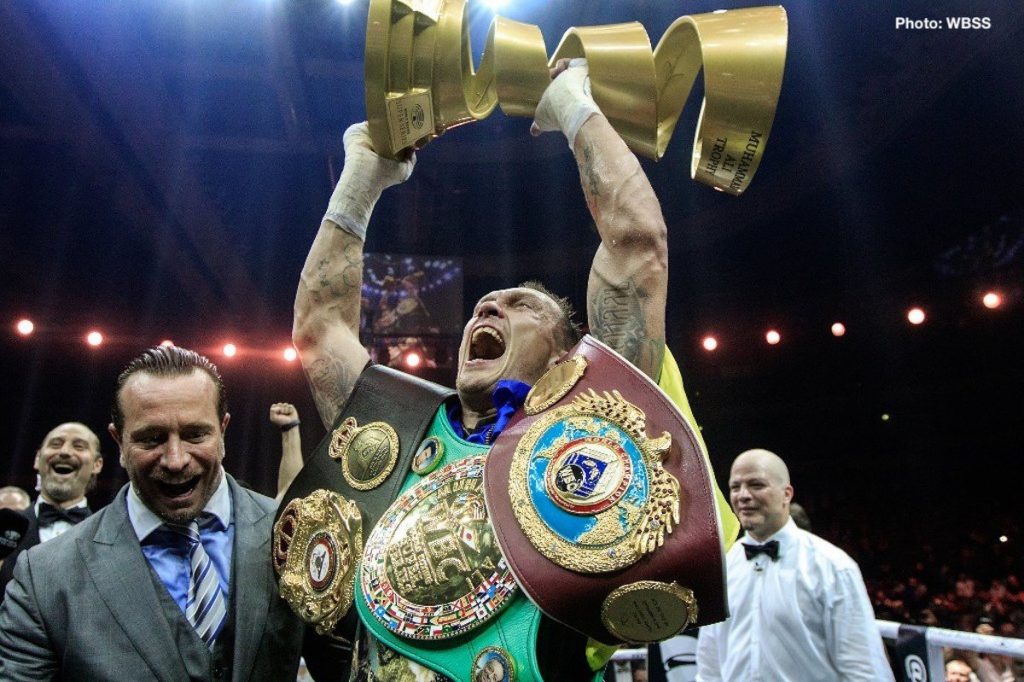A new question of geometry: Usyk attritions Witherspoon in heavyweight

By Bart Barry-
Saturday in Chicago, 2018’s best fighter, Ukrainian
Oleksandr Usyk, made his first-yet heavyweight prizefight against former
American contender Chazz Witherspoon on DAZN, the aficionado’s network. After a yearlong injury layoff Usyk made
Witherspoon quit after seven rounds in a turn unsurprising as it was
undramatic.
We have seen the best of Usyk. Years from now, after Usyk is at least a
partially unified heavyweight champion of the world and myriad casuals know him
for it, we can look back at the World Boxing Super Series of 2018 and know we
saw the best version of him, the same way aficionados look at 2006 Manny
Pacquiao and know, whatever his achievements in the 13 years that followed (or
23; hell, he may regularly undress PBC welterweights till he’s 50), Pacquiao never
was better than the 130-pounder who stopped Erik Morales a twotime before decisioning
Juan Manuel Marquez and redecisioning Marco Antonio Barrera. As Pacquiao scaled heavier, questions arose
about his power and durability and agility but no one ever doubted he was a
better boxer than his new foes at lightweight, junior welterweight,
welterweight and junior middleweight (mind the ‘new’ there; never did Pacquiao
outbox Marquez at any weight).
No one, either, will doubt Usyk is a better boxer
than everyone he faces the rest of his career.
But can his stamina suffer much harder punches from much larger men? can
Usyk suffer their blows while making them suffer enough to suffer him no more? Those be exactly the questions Saturday tried
to ask.
Witherspoon, a shortnotice opponent in every sense
of the term, was apt an initial interrogator as boxing’s flagship division had
on offer. Since power is the last thing
to go, at age 38 Witherspoon, who reliably looks like an A-level guy against
C-level competition and loses just as reliably to every B-level man he faces, needed
to put a few good punches on Usyk, which he did, and absorb a few good punches
from Usyk, which he did, and tell us if Usyk’s move to the weightlimitless
division was foolhardy.
It wasn’t.
Usyk took punches enough from Witherspoon to prove he can take
heavyweight fire. And he stopped Witherspoon
faster than 2009 Tony Thompson if slower than 2012 Seth Mitchell.
Saturday answered every question of power, yes,
but asked a brandnew question of geometry we mightn’t have imagined
otherwise. The cruiserweights Usyk made
his career undoing were physically narrower, as were the heavyweights Usyk beat
to become an Olympic gold medalist.
It became apparent very quickly Saturday the
precise spinning of Usyk’s signature attack was disrupted by nothing so much as
Witherspoon’s simple girth. The geometry
was wrong; there was now a need to take a wider step round the opponent, which
meant there was no longer the same space between ring center and ropes or corner. This made Usyk fight in wider circles,
requiring more skipping than stepping; Usyk was no longer transitioning
balletically from spinning trap to spinning counter to spinning departure so
much as moving defensively sideways or moving offensively straight forward.
And moving straight at a 240-pound man who knows
how to punch is a different thing altogether from moving straight at a
199-pound man. When a cruiserweight
punching up at you hits your gloves, you expense it to the cost of doing
business at the championship level; when a heavyweight punching level to you or
downwards hits your gloves, it hurts your face and jars your spine.
Usyk is fast and athletic but not so fast and
athletic that a nearing-40 Chazz Witherspoon couldn’t countertouch him with
righthands. Is that a detail ruinous to
Usyk’s prospects at heavyweight?
No, and the reason why came at the end of
Saturday’s match. The tale was told in
Witherspoon’s stature and aerobics, not his bleeding mouth. How open that mouth was and how wilted his
posture, both, indicated what made Usyk unique among cruisers and’ll make him superunique
among heavies. Usyk is an attrition
hunter who runs his prey to unconsciousness.
An attrition hunter needn’t fell a beast with a single hurl of the spear
– he need only pain his prey enough to make it flee. Once it runs, he has it.
Witherspoon sagged on his stool after round 7 like
a sealevel mammoth marched up Mount Everest.
Thirty seconds into its postround rest Witherspoon’s body had yet to
contemplate recovery, certain as it was about drowning.
What does that say about Usyk’s prospects against
AJ? Everything. Men with a third Usyk’s talent and craft collaborate
with Joshua’s massive pecs, delts, traps and bis to fatigue him by midfight. And Joshua’s June (and December) conqueror,
Andy Ruiz, is nothing so much as a fat cruiserweight loosed on giants who are
basic.
Which brings us to the one genuinely compelling
challenge for Usyk: Deontay Wilder. Nobody
at cruiserweight hits fractionally so hard as Wilder, but no one at heavyweight
is near so physically narrow as Wilder.
The geometry of Wilder’s width is all right for Usyk, while the geometry
of Wilder’s height is not. Neither is
Wilder’s conditioning, which absolutely rivals Usyk’s. A Wilder-Usyk unification match in 2021 will make
the most-athletic heavyweight prizefight in 25 years.
Bart Barry can be reached via Twitter @bartbarry